Memorialised in Manuscript: A Unique First World War Honour Roll
Memorial lists recording the names of people who have died in service to their country or local community are a tragic, but important, part of library and institutional collections worldwide. For the First World War alone, Special Collections holds seventeen separate registers published between 1919 and 1926. There is, however, one further register in the collection that was neither printed nor published, but artfully crafted by a member of university staff.
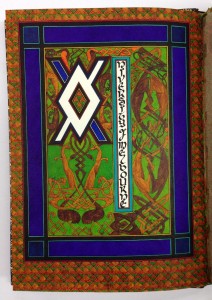
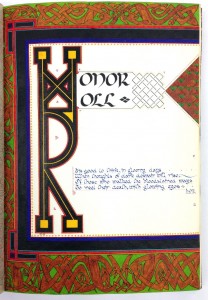
This manuscript Honour Roll was created by Vincent J. Hearnes, chief mechanic in the Department of Metallurgy workshop during the early 1930s.[1] According to an index card enclosed in the book, one of Hearnes’ hobbies was the production of books and decorative texts using coloured inks he prepared. This Honour Roll is one surviving example of his work.
The book consists of 34 hand-decorated leaves recording in a calligraphic script the names of 102 graduates killed on active service between 1914 and 1918.[2] Hearnes was clearly influenced by medieval manuscript decoration and Celtic art, but added an Australian touch by using eccentrically stylised kangaroos and emus to form his knotwork patterns as exemplified in the previous images.
Rather than design decorated initials for each individual name, Hearnes instead used either one large initial for all the names on a given page, such as in the first and third examples below, or incorporated multiple initials into a single design element, e.g. the combination of ‘E’, ‘F’ and ‘G’ in the middle image.
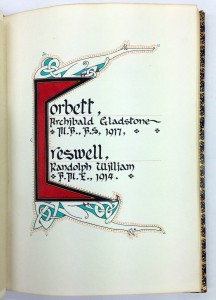
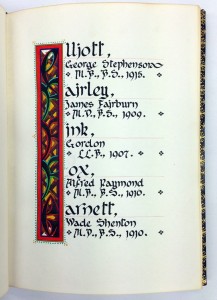
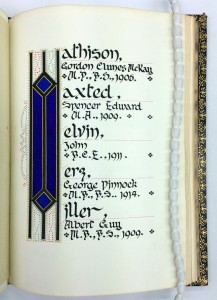

The work was also a collaborative production. The book was tastefully bound in blue (the university colour) pebble-grained morocco with ornamental gilt turn-ins and marbled endpapers by the prominent Melbourne binder Harry Green. There are brief contributions by Professors L. J. Wrigley (Department of Education) and J. Neill Greenwood (Department of Metallurgy), and an Introduction was provided by noted historian Professor (Sir) Ernest Scott.[3]
When and why did Hearnes compile the manuscript? Thanks to the colophon, we know he completed the Honour Roll in March 1932. The year is significant for two reasons. First, the twentieth anniversary of the outbreak of World War I was just two years away. Second, Melbourne’s war memorial, the Shrine of Remembrance, was under construction and scheduled to open in time with the anniversary in 1934.
To create a record of the Victorians who served overseas between 1914 and 1918, the committee tasked with founding and constructing the Shrine opted to have the names inscribed in a series of Books of Remembrance.[4] To ensure the longevity of the books, they sought the advice of the Victorian Arts and Crafts Society, which specified: ‘The books will be made of the best Roman Vellum, and hand bound in Levant Morocco … The binding would be done by Mr Harry Green, one of the best craftsmen in Australia in the production of Edition de Luxe. The lettering would be done by [Jason] S. Forman and assistants’.[5]
Although Hearnes’ Honour Roll was also bound by Green, he was not among Forman’s assistants, though it seems evident that their work inspired Hearnes to create a similar Book of Remembrance focused on graduates of the university.[6]
The Honour Roll was not the only calligraphic work Hearnes wished to present to the library. In a letter to the Registrar dated 5 April 1933, he wrote: ‘As I mentioned some months ago, I intended having another manuscript book finished for presentation … this year, but owing to illness … I have been unable to do any considerable amount of drawing’.[7] The letter closed with an offer of a third manuscript, one comprised of prayers written alternately in Irish and Latin. Neither book mentioned, however, is held by Special Collections.
Eight months after writing to the Registrar, Hearnes was dismissed from the university due to conflict with other staff, which, it is safe to presume, also ended any inclination on his part to donate further books.[8] This makes the Honour Roll the sole example of his calligraphic work held by the library, and a fitting object to write about, as we enter the final months of the centennial year marking the start of the First World War and prepare to commemorate the centenary of the costly Gallipoli Campaign in 2015.
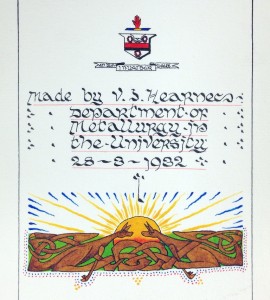
Anthony Tedeschi (Deputy Curator, Special Collections)
[1] Essington Lewis, Development and Activities of the Metallurgy School … Melbourne: Melbourne University Press, 1935, p. 7.
[2] For the official university Roll of Honour, see The Melbourne University Magazine: War Memorial Number … Compiled by Graduates and Undergraduates of the University … Melbourne: [Printed by Ford & Son for Melbourne University Magazine], 1920.
[3] Scott was knighted in 1939. The School of Historical and Philosophical Studies maintains a chair in his honour, and the university awards an annual prize in Scott’s name, which was established by his widow, Lady Emily Scott (1882–1957).
[4] The books, which number forty in total, are housed in individual bronze caskets displayed in the Ambulatory.
[5] J.B. Forman to Philip Hudson, 10 October 1929; quoted in Bruce Scates, A Place to Remember: A History of the Shrine of Remembrance. Melbourne: Cambridge University Press, 2009, p. 129. Fine vellum proved cost prohibitive, so parchment, cheaper but no less durable, was used.
[6] My thanks to Leigh Gilburt at the Shrine of Remembrance for confirming Hearnes was not among the calligraphers.
[7] V. J. Hearnes to the University Registrar, 5 April 1933; the letter is enclosed with the Honour Roll.
[8] File ‘H. V. [sic] Hearnes Termination of Employment’; University of Melbourne Archives, Office of the Registrar Collection, UM 312, 1933/ 206.
Categories
- Uncategorised
- Rare Books
- Special Collections
Leave a Reply